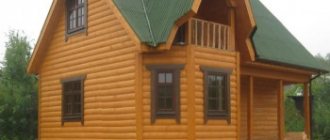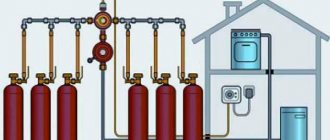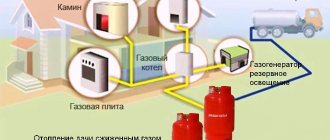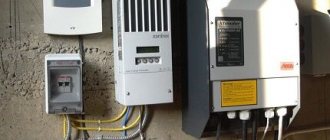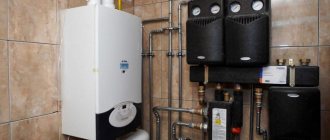In a country with such a harsh climate as Russia, high-quality heating of private residential buildings is a matter of not only comfort, but also safety. This is why most people who decide to move from an apartment to a private house take the issue of heat supply very seriously.
Option for planning a house with a boiler room
Of course, at the planning stage they are most interested in house designs with a boiler room. The boiler room provided for during the design usually meets a number of requirements placed on it by specialists and ordinary users. And every person who orders a project for their future home from a specialized company needs to know about them. In addition, you need to know what stages you will have to go through when designing a house with a boiler room.
It is especially difficult to comply with all the standards if you order a project for a small one-story house with a boiler room. Since in this case it is necessary to comply with safety requirements and not take up too much space, otherwise the area of other rooms in the cottage will be reduced.
Design stages
Today, in order to install a heating boiler in your private home, you will have to go through a number of not so simple procedures, both technical and legal.
Installation diagram of a heating installation in a two-story house
Of course, starting work without knowing about them is simply reckless and even stupid. So, what stages is it customary to divide all the work into?
- Project development. Guided by the data provided by you, specialists design a boiler room in a private house. At the same time, they select the optimal location for the boiler room, as well as the equipment that will be used during work. A number of criteria are taken into account here: the power of the heating boiler, the type of fuel it uses during operation, the size of the house and premises, the main building material from which the house is built, and much more.
- Project approval. To do this, you will have to go through a number of specialized government agencies. In most cases, this is necessary if you choose gas heating boilers: they require a connection to the gas pipeline, and this work can only be carried out by representatives of specialized organizations.
An example of a house project with a boiler room for approval.
In this case, all activities related to the installation and commissioning of equipment are carried out by the contractor company. She bears full responsibility for mistakes made during work. The home owner can choose a contractor company at his own discretion. - Adaptation of the room where heating equipment is installed so that it meets all the requirements of regulatory documents. This includes a number of measures for fire safety, natural and artificial lighting and supply and exhaust ventilation.
In most cases, completing all these steps is enough to enable you to install all the necessary heating equipment in your new home.
Layout
The correct placement of boiler equipment is an issue that can only be resolved by knowing the area of the room, the complete list of necessary devices and their dimensions. In most cases, in order to avoid annoying mistakes when arranging equipment, it is advisable to contact a professional design and installation organization.
This is what one of the FORUMHOUE participants decided for himself about this.
pavellarinForumHOUSE user, Moscow.
I try to do everything in a normal, formal and beautiful way. Example: I installed a chimney (“Schidel”) with a ventilation duct. When coordinating the gas supply project for the house, the girl engineer spent a long time asking how these elements were organized, what and how they were made. All this is reflected in the technical specifications. The project was approved by the regional gas authority without any problems. After approval, a condition appeared in the technical specifications regarding the organization of a lattice opening in the lower part of the entrance door.
But you can give some general recommendations regarding breading even before its development begins.
Thus, unobstructed access to the heating boiler must be organized. This condition must be met even in cases where the device does not require regular refueling (meaning an electric or gas boiler). The distance from the walls of the boiler room to the equipment installed in it must comply with the requirements in the technical documentation diagrams for these devices. If we are talking about the layout of lighting fixtures, then they should comprehensively illuminate the space - in case you need to make minor repairs (replacement of pumping equipment, repair of boiler automation, etc.).
Photo of a boiler room in a private house.
Unobstructed access should be organized not only to the heating boiler, but, if possible, also to other devices - to the circulation pump and electrical switches, to the boiler and ventilation holes, to pumping equipment, chimney elements, etc. Take care of convenience in advance! After all, this will help to avoid difficulties in the process of further operation.
Where is the best place to locate the boiler room?
A heating boiler, even if all required safety rules are observed, is a source of increased fire hazard. Therefore, you should approach the choice of the place where it will be installed very responsibly and seriously. It is necessary to consider not only the cost of placement and operational safety, but also ease of use. Based on this, there are three main ways to locate a boiler room.
The first is out-of-home placement. It should be said right away that this method is as expensive as it is safe.
Of course, on the one hand, placing the heating boiler 5-10 meters from the house ensures that in the event of a gas or diesel leak or an accidental fire of solid fuel, nothing will threaten your home.
But keep in mind that you will have to develop a separate drawing, pour an additional foundation, think about installing external utility networks and their thermal insulation.
pouring the foundations for the boiler room
You will have to spend a lot of money and time. And the ease of use is significantly reduced. Secondly, if the designs of houses with a boiler room were initially developed taking into account the installation of the necessary equipment, then the heating boiler can be located on the ground floor or even in the basement. Most people prefer to place it in the basement. Then you won’t have to allocate 15-16 square meters of usable space on the ground floor, which means that the freed up space can be used to greater advantage.
To install a diesel boiler or solid fuel boiler, it is necessary to provide a separate room: when coal, wood, peat or diesel fuel is burned, a large amount of smoke is released, which can cause certain problems for the inhabitants of the house. Well, even the most economical owner can allocate 15 square meters when building luxurious two-story houses with a boiler room.
Plan of a two-story house with a boiler room
If you prefer an electric heating boiler or a not too powerful (no more than 30 kW) gas boiler, then you can install the equipment in the kitchen. Modern equipment is small in size, so it is not noticeable and does not take up extra space. If desired, you can even choose special wall-mounted boilers that take up virtually no useful space in the room.
Of course, the kitchen must have high-quality ventilation, and simply monitoring the condition of the equipment will never be superfluous.
After all, the slightest gas leak is enough to destroy an entire house, along with the people living in it.
And finally, an option that allows you to combine the advantages of the two described above and at the same time, partially get rid of their disadvantages. When designing wooden houses with a boiler room, you need to provide a small extension in advance.
Project of a wooden house with a boiler room
A foundation is also poured under it, which is part of the main foundation. In most cases, extensions are made from lightweight materials (frame construction), which allows you to save a considerable amount during construction. This simplifies the organization of high-quality ventilation. As a result, you get a boiler room, which is located in close proximity to the house. Thanks to this, you will not have to spend extra money on laying the pipeline.
At any time you can enter the extension both from the side of the house and from the street: in most cases, extensions are equipped with two doors. If a gas leak (carbon monoxide or explosive) occurs, the risk of serious damage to the main building is minimized. Therefore, an extension to the house dedicated to the boiler room can be called the optimal solution.
How to build a boiler room for a private house
Today, there is a standard list of equipment that needs to be placed in any boiler room, regardless of its type. Let's look at it in more detail:
- The heating boiler is the main source of heat for your home and the central element of the boiler room, capable of transforming fuel energy into thermal energy;
- A boiler is an optional and bulky element designed to heat water used for domestic needs;
- Expansion tank - an element that allows you to equalize pressure in heating systems;
- Distribution manifold - a device that distributes coolant flows in multi-circuit heating systems;
- Chimney - a system of exhaust elements that remove fuel combustion products to the external space, i.e. to the street (not used in electric heating systems);
- Circulation pump - a device that accelerates the circulation of coolant (installed in the boiler room);
- Safety group with safety valve and air vent system.
- Pipeline system with shut-off valves;
- Ventilation system.
And one more necessary element of a modern “stoker” is a system for controlling gas pollution in the room. For safety reasons, it is recommended to equip it in any gas boiler rooms (see photo).
fahrenheitFORUMHOUSE user
The old SNiP 2.04.08-87 did not provide for this; now, if you have a basement, basement or extension, then gas control is required! I quote: “Indoor gas control systems with automatic shutdown of gas supply in residential buildings should be provided when installing heating equipment: regardless of the installation location - with a power of over 60 kW; in basements, ground floors and in extensions to the building - regardless of thermal power.”
We have listed the main elements of an ideal boiler room. And the availability of additional individual boiler equipment and its list will depend solely on the type of heating system and the type of fuel used. Now we need to see how the correct arrangement of the main elements will be done.
Specifics of frame houses with a boiler room
A separate room for a boiler room is a mandatory requirement of the Ministry of Emergency Situations. In a cottage that has been in use for a long time, it is no longer possible to equip it. This must be taken into account during construction. For a frame house, such a room has signs of increased danger - there are trees all around. Therefore they have the following features:
- Built-in or attached boiler room. The first is installed in the house on the ground floor next to the bathroom and vestibule with a separate entrance and window. The second one is built from the street and has no entrance from the inside (only through the street).
- High quality fire protection. All wooden surfaces are treated with a special fire-resistant compound - fire retardant. Its concentration for the boiler room should be higher than for other rooms.
- Thermoregulation. The room with heating equipment should not be hotter than other rooms. Excess heat is absorbed by special finishing materials and removed outside through ventilation.
- Water pipes. Access to it should be, if not in the room itself, then in the adjacent one.
- Window. This is a prerequisite for a boiler room in a frame house. In case of an emergency, it will avoid severe damage.
The presence of a boiler room does not affect the structure of the frame base. All the above-described features are taken into account at the design and finishing stage.

